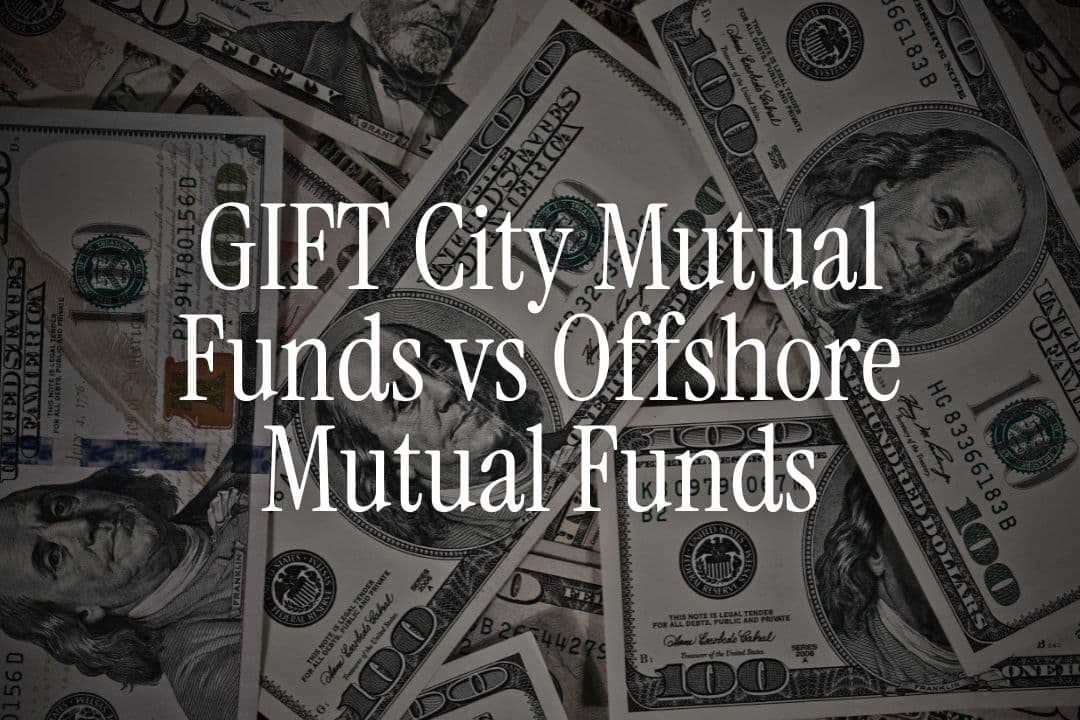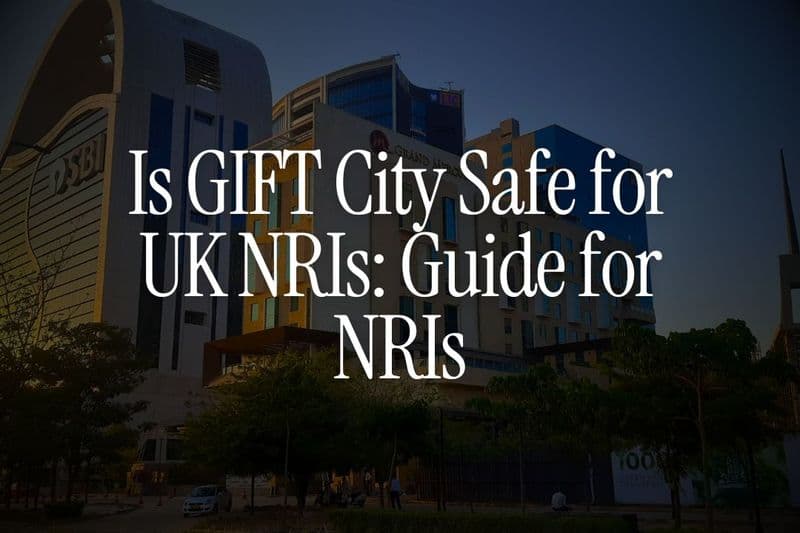
Vikram, a software engineer in Silicon Valley, invested $50,000 in an HDFC equity fund. Three years later, his returns looked great.
But come tax season, he owed the IRS $8,000 in penalties because his Indian mutual fund was classified as a PFIC (Passive Foreign Investment Company). His colleague Priya invested the same amount in a GIFT City AIF.
Her tax bill? Zero in India. Manageable in the US.
If you're an NRI deciding between GIFT City funds and traditional offshore mutual funds, this question determines how much of your returns you actually keep.
At Belong, we work with thousands of NRIs through our WhatsApp community who face this exact choice. The answer isn't simple. It depends on where you live, how much you're investing, and what you want to achieve.
This guide compares GIFT City mutual funds (technically AIFs) against offshore funds across tax treatment, compliance, currency risk, minimums, and who should choose what.
By the end, you'll know exactly which structure works for your situation.
What Are GIFT City Mutual Funds?
GIFT City (Gujarat International Finance Tec-City) is India's first International Financial Services Centre. It's a special economic zone in Gandhinagar with its own regulator, the International Financial Services Centres Authority (IFSCA).
Funds operating in GIFT City are technically offshore. They're structured as Alternative Investment Funds (AIFs) or, increasingly, as retail mutual fund schemes. They invest in global markets including Indian equities, US stocks, bonds, and other securities.
Key characteristics:
- Denominated in foreign currencies (USD, EUR, GBP)
- Regulated by IFSCA (not SEBI or RBI)
- Operate like offshore funds but within India
- Fully compliant with FATCA/CRS reporting
Current offerings: Over 200 AIFs managing billions in assets. Categories include equity funds, debt funds, and hybrid strategies (source: IFSCA).
Minimum investment: Category I and II AIFs typically require $150,000. Category III AIFs may have lower minimums. New retail mutual fund schemes in GIFT City are available with minimums as low as $500.
Learn more: GIFT City Funds for NRIs
What Are Offshore Mutual Funds?
Offshore mutual funds are investment funds domiciled outside your country of residence. Popular jurisdictions include Luxembourg, Ireland, Cayman Islands, Mauritius, and Singapore.
These funds pool money from international investors and invest globally. They're typically UCITS-compliant (European standard) or operate under similar frameworks in other jurisdictions.
Examples:
- Fidelity International funds (Ireland)
- BlackRock Global Funds (Luxembourg)
- JP Morgan funds (various jurisdictions)
Key characteristics:
- Domiciled in tax-neutral or low-tax countries
- Often UCITS-compliant for European investors
- Wide range of asset classes and strategies
- Designed for cross-border investors
Minimum investment: Varies widely. Retail classes start at $1,000-5,000. Institutional classes require $100,000+.
Tip: For UAE-based NRIs with no US connection, both GIFT City AIFs and offshore UCITS funds offer tax efficiency. The choice depends on investment minimums and desired market exposure.
The Tax Treatment: Where GIFT City Wins Big
This is the core difference. Let's break it down by investor location.
For UAE/GCC-Based NRIs
GIFT City AIFs:
- Zero tax in India (no TDS, no capital gains tax)
- Zero tax in UAE (no income tax)
- Result: 100% tax-free returns
Offshore Funds (Luxembourg/Ireland):
- Zero tax in UAE (no income tax)
- May face withholding tax in fund's domicile (typically 0-15% on dividends)
- Result: Mostly tax-free, some dividend withholding possible
Verdict: Both work well for UAE residents. GIFT City has slight edge on dividend taxation. Zero withholding versus potential 10-15% in European funds.
For US-Based NRIs (This Is Where It Gets Critical)
Indian Mutual Funds (NOT GIFT City):
- Classified as PFICs by IRS
- Require annual Form 8621 filing
- Subject to punitive taxation including tax on unrealized gains
- Effective tax rate can hit 40-50% including penalties
- Nightmare compliance burden
Also Read - Types of Mutual Funds
GIFT City AIFs:
- Generally not classified as PFICs if structured properly, though certain AIFs may still qualify as PFICs under US rules. (source)
- Taxed as regular foreign investment
- Capital gains taxed at 15-20% (long-term)
- Dividends taxed at ordinary income rates
- Far simpler compliance
- Fund obtains EIN, files as pass-through entity
Offshore UCITS Funds:
- Generally not PFICs if they meet diversification tests
- Taxed as regular mutual funds
- Capital gains at 15-20%
- Dividends at ordinary rates
- Clean US tax treatment
Verdict: For US NRIs, both GIFT City AIFs and offshore UCITS funds beat Indian domestic mutual funds. GIFT City offers India exposure without PFIC hell. (Source: IRS PFIC rules, verified with US tax advisors)
Tip: If you're a US NRI, never invest in regular Indian mutual funds. Use GIFT City AIFs or US-domiciled India funds instead. The PFIC tax burden can wipe out all your returns.
Learn more: NRI Capital Gains Tax India
For UK-Based NRIs
GIFT City AIFs:
- Zero tax in India
- Subject to UK tax on worldwide income
- Capital gains: 18-24% depending on income
- Can claim foreign tax credit under India-UK DTAA
Offshore Funds (UCITS):
- Zero/low tax at source
- Subject to UK tax on worldwide income
- Reporting funds vs non-reporting funds matter
- Non-reporting funds taxed at income rates (up to 45%)
- Reporting funds get capital gains treatment (10-20%)
Verdict: Both work. Ensure your offshore fund has UK reporting status. GIFT City offers India-specific exposure with clean tax treatment.
For Singapore/Hong Kong NRIs
Both GIFT City and Offshore:
- Zero capital gains tax at home
- Only dividend withholding matters
- GIFT City: Zero withholding
- Offshore funds: 0-25% withholding
Verdict: Both excellent. GIFT City wins on dividend tax.
Read: DTAA Countries List
The PFIC Problem: Why US NRIs Must Avoid Indian Mutual Funds
This deserves its own section because it's the biggest trap for US-based NRIs.
What is a PFIC?
Passive Foreign Investment Company. Any non-US fund where 75%+ income comes from passive sources (interest, dividends, capital gains).
Why does it matter?
IRS treats PFICs punitively to discourage US citizens from hiding money in offshore tax havens.
The nightmare taxation:
- You pay tax on unrealized gains (mark-to-market)
- When you sell, gains are taxed at ordinary rates (up to 37%)
- IRS adds interest charges on deferred tax
- You must file Form 8621 annually (complex, expensive)
- Missing filings = $10,000 penalty per year
Also Read - Taxation on Mutual Funds
Real example:
You invest $10,000 in an HDFC equity fund. It grows to $15,000.
You pay tax on $5,000 gain even if you don't sell. Then it drops to $12,000. You can't claim the $3,000 loss easily.
When you finally sell at $14,000, you're taxed again on the full $4,000 gain at ordinary rates (35%+). Plus interest charges. Your effective tax? 40-50%.
The solution:
GIFT City Category 3 AIFs that invest in Indian mutual funds (not directly in stocks) are structured to avoid PFIC classification.
The fund pays tax at fund level in India, and you're taxed as a limited partner, not a PFIC investor.
(Source: Multiple US tax advisors, GIFT City fund structures)
Tip: If you're a US NRI wanting India exposure, your options are: GIFT City AIFs, US-domiciled India ETFs (like INDA, INDY), or direct stock investing through GIFT City exchanges. Never regular Indian mutual funds.
Currency Considerations: USD vs INR Exposure
GIFT City Funds:
- Denominated in USD, EUR, or GBP
- You invest and redeem in foreign currency
- No INR conversion required
- Protects against rupee depreciation
- Perfect for NRIs who think in dollars
Traditional Indian Mutual Funds:
- Denominated in INR
- You convert foreign currency to rupees
- Returns impacted by currency movements
- If rupee depreciates 5% annually, your 12% equity return becomes 7% in dollar terms
Offshore UCITS Funds:
- Typically USD or EUR denominated
- Clean currency exposure
- No INR risk
Example:
You invest $10,000 in a GIFT City AIF focused on US tech stocks. NAV grows 15% over 3 years. You redeem $11,500. Clean and simple.
You invest $10,000 (₹8 lakhs at 1 USD = ₹80) in an Indian equity fund. NAV grows 15% to ₹9.2 lakhs. But rupee depreciated to ₹85 per USD.
You get back $10,823. Your dollar return? Only 8.2%.
(Historical data: RBI shows INR depreciates 3-5% annually vs USD)
Tip: Use our Rupee vs Dollar Tracker to see historical trends and understand currency impact on your returns.
Also Read - How Inflation in India Impacts Your Retirement Savings
Repatriation: Getting Your Money Out
GIFT City Funds:
- Fully repatriable to any country
- No RBI approval needed
- No forms, no TDS, no paperwork
- Funds stay in foreign currency throughout
Indian Mutual Funds:
- Repatriable but with steps
- Must pay TDS (12.5% on long-term gains)
- Need to convert INR to foreign currency
- Banks charge 1-2% on forex conversion
- For NRO account investments, $1 million annual limit applies
Also Read - Comparing Indian Mutual Funds vs UAE Mutual Funds
Offshore UCITS Funds:
- Fully repatriable to any country
- No restrictions
- Clean process
Verdict: GIFT City and offshore funds tie on repatriation ease. Both beat traditional Indian mutual funds.
Learn more: Ways to Avoid NRI Tax Payment Penalties
Also Read - GIFT City vs Regular Indian Mutual Funds
Minimum Investment: The Barrier to Entry
GIFT City AIFs:
- Category I & II: $150,000 minimum (for sophisticated investors)
- Category III: $150,000 typical, some lower
- New retail mutual fund schemes: $10,000-25,000 (emerging)
- Through Belong's partnership: Access to select AIFs with $50,000+ minimums
Traditional Indian Mutual Funds:
- Minimum: ₹500-5,000 ($10-100)
- Highly accessible
- But remember PFIC issues for US NRIs
Offshore UCITS Funds:
- Retail share class: $1,000-5,000
- Institutional class: $100,000-250,000
- Most accessible for smaller investors
Verdict: Offshore UCITS funds win on accessibility for smaller amounts. GIFT City is for high-net-worth investors ($150K+). Traditional Indian MFs accessible but tax-problematic for some NRIs.
Tip: If you have less than $150,000 to invest, offshore UCITS funds or GIFT City fixed deposits make more sense than GIFT City AIFs.
Also Read - Impact of FEMA Rules on NRI Mutual Fund Investments
Regulatory Oversight and Safety
GIFT City AIFs:
- Regulated by IFSCA
- Combines powers of RBI, SEBI, IRDAI, PFRDA
- International standards
- Fund managers licensed and monitored
- Quarterly reporting requirements
- Same Indian banks and AMCs (HDFC, ICICI, etc.)
Indian Mutual Funds:
- Regulated by SEBI
- 40+ years of proven framework
- Strong investor protection
- Daily NAV disclosure
- Stringent compliance
Offshore UCITS Funds:
- Regulated by national authorities (Luxembourg's CSSF, Ireland's Central Bank)
- UCITS framework = strong investor protection
- Daily NAV, quarterly reports
- Depositary oversight
Verdict: All three are safe if you choose reputable funds. GIFT City and offshore UCITS offer global standards. Indian mutual funds have longer track record.
Read: GIFT City IFSC Explained
Compliance and Reporting Burden
For UAE/GCC NRIs:
GIFT City: Minimal. Fund reports to IFSCA. You get annual statements. No tax filing needed in UAE.
Offshore UCITS: Minimal. Annual statements. No UAE filing.
Indian MFs: More complex. TDS certificates, capital gains calculation, may need to file Indian taxes if you have other India income.
For US NRIs:
GIFT City: Moderate. Report on FBAR if aggregate foreign accounts > $10,000. Report on FATCA Form 8938 if foreign assets > $200,000. Standard capital gains reporting on Schedule D.
Offshore UCITS: Same as GIFT City. FBAR, FATCA, Schedule D.
Indian MFs: Nightmare. All of above PLUS Form 8621 for each PFIC fund annually. Compliance cost $500-2,000 per year per fund.
For UK NRIs:
GIFT City: Moderate. Report on Self Assessment. Foreign income pages.
Offshore UCITS: Ensure fund has UK reporting status. Then clean reporting. Non-reporting funds = higher tax.
Verdict: For US NRIs, GIFT City and offshore UCITS have similar compliance. Both beat Indian MFs. For UAE NRIs, all three are easy, GIFT City slightly cleaner.
Who Should Choose GIFT City Funds?
Choose GIFT City AIFs if:
1. You're a High-Net-Worth NRI ($150K+ to Invest)
You meet the minimum threshold. You want India exposure without currency risk or complex taxation.
2. You're a US-Based NRI Wanting India Exposure
GIFT City AIFs avoid PFIC classification. This is your clean path to Indian equities and bonds without IRS nightmares.
3. You Want Tax-Free Investment Growth
Zero tax in India. Pay only in your country of residence (zero in UAE, manageable in US/UK/Singapore).
4. You Prefer Indian Fund Managers
You trust Indian AMCs (HDFC, ICICI, Aditya Birla). You want their expertise managing global portfolios from GIFT City.
5. You're Planning Long-Term (5-10 Years)
GIFT City AIFs typically have 3-5 year lock-ins. You're comfortable with illiquidity for superior tax treatment.
Check: GIFT City Investments Guide
Who Should Choose Offshore UCITS Funds?
Choose offshore mutual funds if:
1. You Have Smaller Amounts to Invest ($5,000-50,000)
You don't meet GIFT City minimums. Offshore UCITS funds start at $1,000-5,000.
2. You Want Daily Liquidity
Offshore mutual funds allow redemptions with 1-3 day settlement. No lock-in periods.
3. You Want Broader Global Exposure
Offshore funds offer everything: US tech, European equity, emerging markets, commodities, currencies. GIFT City selection is growing but still limited.
4. You're Comfortable with Established Global Brands
You prefer BlackRock, Fidelity, JP Morgan, Vanguard. You trust these 50+ year old institutions over newer GIFT City structures.
5. You're Not Focused on India
If you want global diversification and India is just one part, offshore UCITS funds offer one-stop shopping.
The Hybrid Strategy (What We Recommend)
Don't choose one. Use both strategically.
For a $300,000 investment corpus:
60% ($180,000) in GIFT City AIF: India-focused equity/debt fund. Tax-free in India. Captures India's growth. Managed by trusted Indian AMCs. 3-5 year horizon.
40% ($120,000) in Offshore UCITS Funds: Global equity fund, US tech fund, emerging markets fund. Daily liquidity. Diversification outside India.
Why this works:
- You maximize tax efficiency (GIFT City)
- You get global diversification (offshore)
- You maintain some liquidity (offshore daily redemptions)
- You hedge currency and geography
Tip: Rebalance annually. If India outperforms, book GIFT City profits into offshore funds. If global markets crash, shift offshore to GIFT City at lower valuations.
How to Invest in GIFT City AIFs
Step 1: Check eligibility. You need to be NRI/OCI with $150,000+ minimum (varies by fund).
Step 2: Complete KYC. Passport, visa, address proof, PAN (if you have one, not mandatory for GIFT City).
Step 3: Choose your fund. Options include:
- India-focused equity AIFs
- Global equity AIFs
- Debt-oriented AIFs
- Hybrid strategies
Step 4: Fund your investment. Transfer from your foreign bank account or NRE account.
Step 5: Monitor and report. You'll get quarterly updates. Report on FBAR/FATCA as needed.
Through Belong: We're partnering with GIFT City funds to offer curated access. Download the Belong app or join our WhatsApp community to learn about new launches.
Learn more: Best Investment Platforms for NRIs
Common Mistakes to Avoid
Mistake 1: US NRIs Investing in Regular Indian Mutual Funds
This triggers PFIC taxation. Your compliance costs and tax burden can exceed your returns. Always check if a fund is PFIC before investing.
Mistake 2: Ignoring Currency Risk
Investing in INR-denominated funds when you spend in USD/AED. Rupee depreciation can cut your real returns by 3-5% annually.
Mistake 3: Not Checking UK Reporting Status
UK NRIs investing in non-reporting offshore funds. You'll pay income tax rates (45%) instead of capital gains rates (20%).
Mistake 4: Putting All Money in Illiquid GIFT City AIFs
Lock-in periods of 3-5 years. Keep 30-40% in liquid investments (offshore funds, GIFT City FDs) for emergencies.
Mistake 5: Not Consulting Tax Advisor
Cross-border taxation is complex. Spend $500-1,000 on proper tax advice before committing $150,000+. It pays for itself.
The Final Verdict
There's no universal winner. Your choice depends on:
GIFT City AIFs win on:
- Tax efficiency (zero tax in India)
- US NRI suitability (no PFIC)
- India-focused exposure
- Trust in Indian institutions
Offshore UCITS Funds win on:
- Lower minimums ($1,000 vs $150,000)
- Daily liquidity (no lock-in)
- Broader global exposure
- Established track records
For most UAE-based NRIs with $150K+: GIFT City AIFs offer superior tax efficiency and India exposure. Add offshore UCITS for diversification.
For most US-based NRIs: GIFT City AIFs are your cleanest path to India. Avoid regular Indian mutual funds at all costs.
For UAE-based NRIs with $10K-50K: Start with offshore UCITS funds. Build corpus to $150K, then add GIFT City.
The worst decision is analysis paralysis. Both structures are far superior to letting money sit in 0.5% UAE savings accounts.
Compare options: NRI Investment Options India Guide
Download Belong App: Get Started
Join 5,000+ NRIs: WhatsApp Community
Check compliance: Compliance Compass Tool
At Belong, we help NRIs invest smarter through education, tools, and community. Whether you choose GIFT City, offshore funds, or both, we're here to guide you.
Disclaimer: For educational purposes. Not personalized investment advice. Consult SEBI-registered advisor and tax professional. Fund performance not guaranteed.
Sources: IFSCA | IRS PFIC Rules | RBI | GIFT City Tax Benefits Analysis




